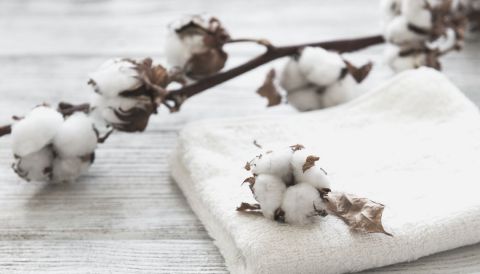Deciding on which bedding to choose for you child is no easy task. Maybe your little one is making a transition to their toddler bed or maybe you are just looking to get a fresh set of bedding. One of the first things you will likely need to decide upon is on which fibre is going to be best for you and your child.
It will not come of any surprise that Kids' are more vulnerable to toxins than adults and they spend a lot of time in and around their bed. Looking at fibres that respect sensitive skins is a likely a good starting point which leads to choosing between the natural fibres, of which cotton would present itself as being the mostly popular and bamboo as an alternative.
Aside from being the primary source of nutrition for pandas, bamboo has earned a reputation for being natural and eco-friendly fibre in textiles. Bamboo is currently used to manufacture consumer products such as shirts, bedding, cloth containers, mattresses, and much more.
What is Bamboo Fibre
Bamboo fibre is a cellulose fibre which has been extracted or fabricated from the bamboo plant. The mechanism by which this extraction or fabrication can vary greatly, but in essences requires a mechanical or chemical process.

The good:
- Bamboo is naturally pest-resistant
As a giant grass, bamboo does not attract deadly pests, making it less dependent on pesticides. A bamboo is so strong and resilient; it will be more likely to suffer from too much water than a pest attack. And if it does get some of these pests, they are mostly biological by nature, which can easily be kept at bay with the use of a non-chemical insecticide. - Bamboo grows incredibly fast even with low water consumption
Unlike many plants, bamboo does not tolerate wet soil very well as its roots will rot as it sits in water. Once it begins to grow, it will not require additional irrigation. - Bamboo cultivation improves soil quality
Bamboo is said to promote soil conservation and rehabilitation of degraded lands. That’s because it can grow in soil that has poor quality and as such, it can utilise available nutrients efficiently. It also makes the soil relatively fertile with its water purification properties. - Bamboo absorbs 5 times more carbon
With global warming and other biodiversity threats becoming more of a real problem in today’s society, many scientists are exploring bamboo as a means of addressing high-carbon emissions. According to one study on carbon sequestration using bamboo plantation, bamboo lands serve as a valuable sink for storing carbon. An hectare filled with bamboo can absorb as much as 17 tons of carbon in a year. - Bamboo produces 35 percent more oxygen than similar trees
A bamboo grove can release more oxygen than hardwoods, making bamboo a crucial element in its balance in our planet’s atmosphere. - Treated bamboo has UV resistance and antibacterial properties
Raw bamboo fabric may actually promote bacterial growth given the dripping moisture from its cellulose fibers. As such, UV rays can pass through it without hindrance. However, scientists have unlocked a way to solve these issues. The bamboo fiber undergoes a special dye treatment using UV-absorbing chemicals. This then provides UV protection as well as antibacterial qualities. In reality, though, these have not been proven to last especially when bamboo has gone through intense rayon processing.
The bad:
While bamboo has the above benefits that come either naturally or chemically through a manufacturing process, not everything that is “bamboo-made” is natural.
- Bamboo has questionable harvest methods in China
While it grows predominantly in the Asian region, China is the only country that grows bamboo on a commercial scale and very little information exists about how it's harvested. They have 500 different bamboo species, and based on a study in 2005, these account for the 2.8 percent of the forested areas. - Bamboo is sourced from the wild
There is a huge concern that some of the bamboo supply comes from the wild and is leading to habitat loss and monocropping. According to an article in Forest Ecology and Management on wild bamboo stands, the sustainability of bamboo harvests in the wild is roughly documented. In addition, its management has been thought of as inappropriate and impractical by experts. - Bamboo manufacturing process raises a number of concerns
As the case for many natural materials, methods companies use to turn bamboo stalks into fibers are a major issue. Using carbon disulfide in the treatment of bamboo has several health consequences such as neural disorders, tiredness, headaches, among others.
Cotton material
Cotton is present in our daily lives. And when it comes kids’ bedding, they are a no-brainer choice. Aside from its fluffy fibers that don’t trap heat, making them soft and comfortable to sleep on, cotton is a durable material by itself, and its fabric can hold up to relentless washing and drying.

The good:
- Cotton is as natural as it gets
Cotton is a natural fiber, which is a renewable and biodegradable resource just like bamboo. Another advantage that comes with being plant-based which cotton shares with bamboo is its hypoallergenic quality. Wearing cotton does not usually cause allergic reactions such that it is often the material of choice for medical bandages and baby clothing. - Cotton retains heat
Many people prefer to wear cotton not only during summer because of its breathable fabric, but also during winter time as it can retain body heat. However, research indicates that wool and nylon materials perform much better in this category than cotton. - Cotton costs lower than bamboo
Mass production has made cotton a relatively cheap purchase. Bamboo bedding costs more than regular cotton sheets, which make the latter a better option price-wise.
The bad:
There is a good reason why bamboo has been getting many fans lately, considering today’s culture of going back to the basics and favoring sustainability over depleting natural resources. Here are some of the cons of cotton use that may influence the environmentally-conscious buyer to go for bamboo materials instead.
- Cotton uses lots of water
It can’t be helped that cotton cultivation and processing require a large amount of H2O, with some experts contending that it is the biggest water consumer in the agricultural crop roster. Cotton’s contribution to water pollution and diversion continues to have a major impact on ecosystems in many cotton-producing countries such as Australia and Pakistan. - Cotton demands lots of pesticide use
Cotton may be considered as pure, however, it is anything but. It is said that 5 to 16 percent of global agrochemical sales (read: pesticides and insecticides) is attributed to cotton cultivation. Its conventional production has resulted in unintended consequences from having less fertile soil to life-threatening health hazards for farmers with their frequent exposure to toxic pesticide chemicals.
How Bamboo Fabric Is Made
The process of turning bamboo into a fibre can be done in three different ways:
- Naturally
This type of bamboo fabric is done mechanically, a process that is very similar to how linen is made. As such, this fabric is often referred to as bamboo linen. It involves crushing of the bamboo wood, followed by using natural enzymes to break it down, which allows the natural fibres to be extracted. This is then spun into yarn which in turn becomes the bamboo textile. Unfortunately, this natural bamboo fabric is not a popular material because of its rough texture, high cost and meticulous manufacturing. - Viscose Rayon
Regenerated cellulose bamboo fibers are manufactured chemically in order to come up with rayon. This is a more widespread bamboo fabric on the market and is picked up by many fashion houses, especially those who promote eco-friendly clothing. Ironically though, this type of bamboo fabric is not exactly produced in the most environmentally sound way. It starts with cooking the bamboo wood and leaves in solvents, which include sodium hydroxide and carbon disulfide to bleach it. - Lyocell-processed rayon
A product of modern technology that creates fibers in a closed-loop manufacturing process, Lyocell deserves the eco tag better than the viscose rayon. Instead of toxic chemicals, it uses amine oxides, which are milder alkalis that disintegrate the bamboo cellulose. These chemicals are recyclable, for the most part, hence very minimal is released as waste. Hydrogen peroxide helps stabilize the solution which eventually hardens the fiber threads.
Is Rayon a natural fiber?
Rayon was the first man-made fiber, which is not synthetic, but not quite natural either. It is made from bamboo pulp, but can also come from wood pulp or other naturally-occurring raw materials such as cellulose. Rayon can be easily blended with other natural fibers to improve its feel, or to reduce its cost.
Rayon may look like a natural fiber, but it doesn't behave like one. This can be confusing because its properties are very similar to cellulose fibers like cotton. However, regenerated fiber such as viscose rayon is not natural, which is further affirmed by the Federal Trade Commission or FTC.
How does organic cotton compare with bamboo?
Organic cotton mitigates much of the pesticide usage of cotton, which makes it on equal footing with bamboo that is produced mechanically. This is further bolstered by the ability of organic cotton in reducing soil erosion and water usage just like bamboo. Both fabric materials are of high quality with their durable and breathable features.
As far as kids’ bedding goes, one that is made from organic cotton can possibly earn a GOTS certification unlike bamboo. GOTS only certifies products made with a majority organic materials and given the process bamboo undertakes to turn it into a fibre, this renders it ineligible.
Conclusion
The properties of bamboo are indeed impressive, but beware of all the claims attached to it. If you prefer your kids’ bedding to be made of bamboo, make sure it’s the kind that has been manufactured in a closed-loop process like Lyocell.
Conventional cotton offers few advantages unless it’s organic, much better still if it’s GOTS-certified. Unfortunately for bamboo, it does not meet the requirements for a GOTS certification so you will not find any product made with it containing a GOTS logo.
In our view, having complete transparency over the entire supply chain is what makes the choice for GOTS-certified kids’ bedding the ultimate one. In other words, cotton, particularly the organic kind, is better than bamboo.

